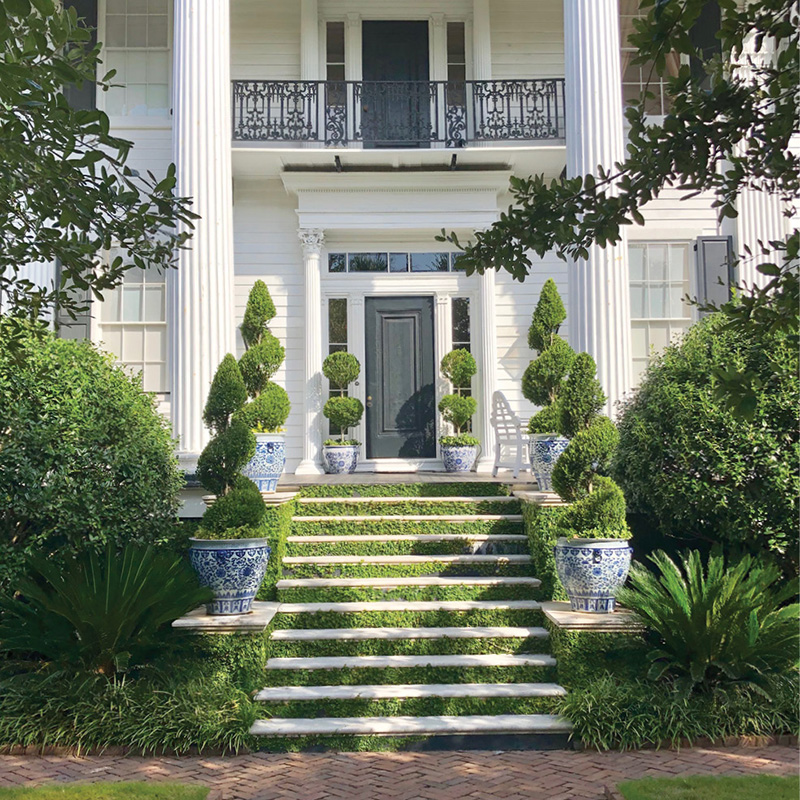Topiary can add evergreen color and architectural form to gardens of all sizes and styles

Manicured boxwoods create a tailored backdrop for annual blooms.
Pay attention during a walk downtown and topiary manifests at every turn. Twin cypress trees spiral beside historical doorways. Boxwoods form tidy parterres. Spheres of ligustrum call for order among flower-bed blooms.
Since debuting in ancient Egypt and Rome, the art of clipping perennial plants (often evergreen shrubs and trees, but also herbs, vines, and more) into ornamental shapes has had grand connotations. After all, it takes a professional gardener to maintain such perfection, right?
Not if you start simple, says Charleston garden editor Joan McDonald. “You can purchase slow-growing shrubs trained and shaped into forms like balls and cones. They do great in containers or in the ground.”
Topiaries serve as foundation plantings, “offering a luscious green you won’t have to change out every season,” explains McDonald. And they can add whimsy to casual gardens as well as more formal affairs, notes Muffie Faith, whose Mount Pleasant shop, Elizabeth Stuart, sells a vast array of the living sculptures.
Ready to try your hand with topiary? Here’s a look at getting started.

Spiral and “poodle” topiaries complement this downtown home’s soaring columns.
Pick Your Place:
■ Identify an entry. Topiaries are ideal for providing vertical interest alongside front doors, as well as for marking the start of a pathway or, say, the gate to a kitchen garden.
■ Incorporate sheared shrubs into a container garden or mixed border. They’ll add a dose of formality—as well as steadfast color—to your collection of seasonal flowers and edibles.
■ Consider giving potted topiaries an understory. McDonald likes to use sedums. “There are a wide variety of options,” she says. “They all set off the topiary’s form without overpowering it and don’t compete too much for nutrition or water.”
■ Start small—literally. “Planted in clay pots, tiny topiaries feel very European and look chic on a garden table or grouped on the porch,” Faith notes. “Bring them in for dinner parties, placing them down the center of the table with small vases of mint, rosemary, and blooms.”
Plant Wisely:
■ Meet light requirements. Most evergreens used in topiary, including varieties of boxwood and cypress, as well as Ligustrum japonicum, prefer full sun to partial shade.
■ To plant in the ground, dig a hole twice as wide as the root ball and mix in well-amended soil.
■ If container-growing, pick a vessel about one-third the height of the shrub. Steer clear of lightweight plastic for top-heavy shapes.
Keep It Neat:
■ Maintain consistent moisture. Water thoroughly when the soil feels dry one inch down. Periodically check the undersides of pots, lightly pruning any roots that have grown over their drainage holes.
■ Prune branches when you see a few inches of new growth in spring, once or twice more in summer, and again in late fall. But don’t stress over a schedule. “I just trim when it looks like the plant needs a haircut,” says Faith, who loves Joyce Chen garden scissors for small jobs.
■ Thin out the interior of the plant and remove dead twigs as needed; you want to be sure light and air can reach the center.
■ Refresh the soil in containers annually, ideally in spring or fall, and transfer plants to larger pots (or into the ground) every couple of years. If any ties are in use, check to make sure they aren’t cutting into the stem.

Field Trip!
Secreted away behind St. John’s Reformed Episcopal Church on Anson Street, the Philip Simmons Heart Garden (below left) is an adventure in topiary art. It began as part of a 1997 Spoleto Festival USA exhibition: Pearl Fryar—the topiary artist whose garden is still open to the public in Bishopville, South Carolina—created its original centerpiece, while Simmons, the late master blacksmith, designed gates and other pieces of ironwork with heart motifs. The Garden Club of Charleston tends the space today. Find more info at philipsimmons.us.